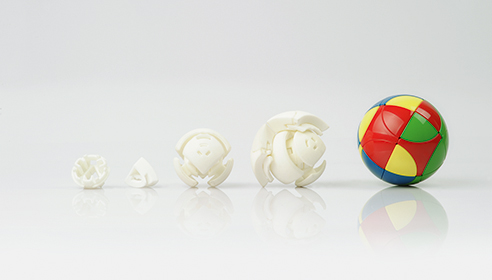Additive Manufacturing Brings Marusenko Sphere 3D Puzzle to Life

The design stages of the Marusenko Sphere, produced with an EOS FORMIGA P 100. Courtesy of EOS.
Latest News
March 3, 2014
Everyone had a Rubik’s Cube when I was a kid, or least a Rubik’s knock-off. The news ran stories about people who could solve the Cube in under a minute, twisting and spinning the puzzle in their hands, while the rest of us could barely keep the colors in order. I solved the Cube only by taking the entire thing apart and putting it back together. Some kids peeled off the stickers.
I bet old Ernő Rubik (inventor of the Rubik’s Cube, if you hadn’t guessed) would have loved to have additive manufacturing to provide rapid prototyping services for him when he was designing the Cube. The current generation of 3D puzzles, the Marusenko Sphere, was lucky enough to have 3D printing around to assist with the design and prototype phases, greatly simplifying the production process.

“Rapid prototyping in an additive process opened the doors to making our product – the all new educational 3D toy ‘Marusenko’ – ready for batch production, but more than that it was the only way to really create the product,” said Victor Troyas, GM at Marusenko S.L. “Without that method it would have been impossible to build a fully working prototype at all.”
The Marusenko Sphere is a much sleeker, more modern looking design than the old Rubik’s Cube, though it does share a number of similarities. Like the Cube, it consists of a number of sections that can be turned and twisted to either scramble the colors, or produce specific designs. Each of 32 exterior pieces turns independently of other pieces, increasing both the difficulty of the puzzle and the difficulty of production.
The design challenge for the Marusenko Sphere was to find a way to build the puzzle without requiring adhesives, springs, screws, or shafts that might pose a risk for children playing with the puzzle. Following extensive CAD design, the project was prototyped using an EOS FORMIGA P 100, which was capable of building the complex internal workings of the puzzle without requiring additional manufacturing.
The final prototype of the Marusenko Sphere consisted of 54 pieces, as does the end product. Employing rapid prototyping rather than traditional manufacturing methods allowed for each piece of the prototype to be reworked quickly and inexpensively in PA 2200 to ensure the entirety of the puzzle would work in the manner in which it was designed.
“Our toy is designed around free movement in predetermined directions,” added Troyas. “The design initially seemed to be quite challenging, but once we had fully discovered the possibilities of rapid prototyping, we knew that we could make it. We were able to make our vision a reality, to make it touchable and useable for everyone.”
Below you’ll find a short video about the Marusenko Sphere.
Source: EOS
Subscribe to our FREE magazine, FREE email newsletters or both!
Latest News
About the Author
John NewmanJohn Newman is a Digital Engineering contributor who focuses on 3D printing. Contact him via [email protected] and read his posts on Rapid Ready Technology.
Follow DE





